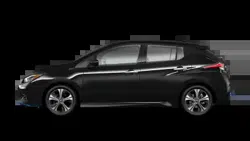Loading ...
Loading ...
Loading ...

• When it is cold, use the steering wheel
heater in substitution for the heater/air
conditioner. The steering wheel heater
consumes less power than the heater/
air conditioner.
• Release the accelerator pedal to slow
down and do not apply the brakes when
traffic and road conditions allow.
–– This vehicle is equipped with a regen-
erative brake system. The primary pur-
pose of the regenerative brake system
is to provide some power to recharge
the Li-ion battery and extend driving
range. A secondary benefit is “engine
braking” that operates based on Li-ion
battery conditions. In the D (Drive) posi-
tion, when the accelerator is released,
the regenerative brake system pro-
vides some deceleration and some
power to the Li-ion battery.
LI-ION BATTERY LIFE
The Li-ion battery's ability to hold a charge,
like all batteries, decreases with battery
age and usage which results in decreased
vehicle range when compared to the ve-
hicle range when the vehicle was new. This
is normal and expected, and does not indi-
cate a malfunction of the vehicle or Li-ion
battery.
The Li-ion battery's ability to hold a charge
can be affected by how you drive the ve-
hicle, store the vehicle, how you charge the
Li-ion battery and Li-ion battery tempera-
ture during vehicle operation and charging.
To maximize the battery's useful life, use
the following driving and charging habits
where possible:
• Avoid exposing a vehicle to extreme am-
bient temperatures for extended periods.
•
Avoid storing a vehicle in temperatures be-
low −13°F (−25°C) for more than seven days.
• Avoid leaving your vehicle for more than
14 days where the Li-ion battery available
charge gauge reaches a zero or near zero
(state of charge).
• Allow the vehicle and Li-ion battery to
cool down after use before charging.
• Park/store your vehicle in cool locations
out of direct sunlight and away from heat
sources.
• Avoid sustained high battery tempera-
tures (caused, for example, by exposure
to very high ambient temperatures or ex-
tending highway driving with multiple
quick charges [if so equipped]).
• Use the normal charging or trickle charg-
ing methods to charge the Li-ion battery
and minimize the use of public Fast
Charge or Quick Charger.
• Moderate driving.
• Use of ECO mode.
• Do not operate the charging timer re-
peatedly while the charge connector is
connected to the vehicle after the Li-ion
battery charging is completed. Doing so
may discharge the 12-volt battery.
• The power of the Li-ion battery can be
checked on the Li-ion battery available
charge gauge. For additional information,
see “Li-ion battery available charge
gauge” (P. 2-9).
LI-ION BATTERY MAINTENANCE
In addition to the regular maintenance rec-
ommended by NISSAN, the LEAF requires
some special Li-ion battery inspections.
• For additional information, refer to the
NISSAN Warranty Information Booklet for
significant limitations, exclusions and
possible voiding of your warranty result-
ing from failure to have these necessary
inspections, repairs and/or adjustments
performed.
• For a detailed explanation of the Li-ion
battery inspection and intervals, see “EV
maintenance schedules (EM57 electric
motor) (P. 9-7).
EV-24 EV Overview
Loading ...
Loading ...
Loading ...
